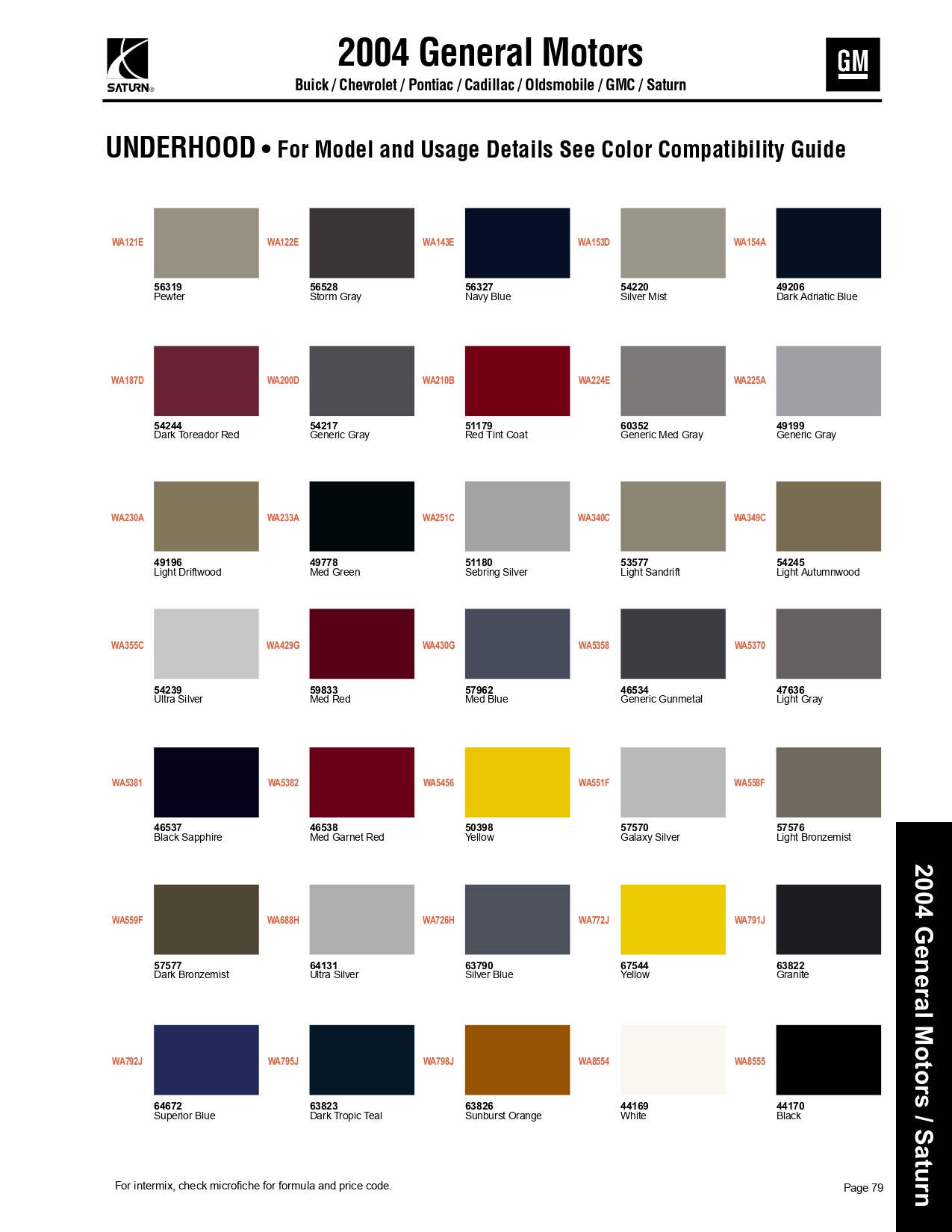Decoding the Matrix: Unraveling GM Paint Color Codes
Ever stared at a vintage Chevy, its paint gleaming under the sun, and wondered how to replicate that exact shade? Or perhaps you're restoring a classic Buick and need a precise color match. The key lies within the cryptic world of GM paint color codes, a lexicon of alphanumeric characters that unlock a spectrum of automotive hues. These codes aren't just random strings; they're the DNA of your car's finish, a precise formula for recreating that factory-fresh look.
General Motors, a titan of the automotive industry, has employed a sophisticated system of paint identification for decades. These codes, often found on a vehicle identification sticker or build sheet, provide a precise reference for the original paint applied at the factory. Deciphering these codes is crucial for anyone undertaking a restoration project, seeking touch-up paint, or simply wanting to understand the history of their vehicle's finish. Imagine these codes as the Rosetta Stone for automotive color, translating a complex mix of pigments and binders into a concise, identifiable format.
The history of GM paint color codes is intertwined with the evolution of automotive paint technology. Early codes were simpler, often reflecting broad color families. As paint technology advanced, so did the complexity of the codes, incorporating information about metallic flakes, pearl essences, and other special effects. This evolution reflects not only the changing aesthetic preferences of consumers but also the advancements in paint chemistry and application techniques.
The importance of these codes cannot be overstated. For restoration enthusiasts, they are the holy grail, the key to achieving an authentic finish. Imagine painstakingly restoring a classic Cadillac only to discover the paint is slightly off. The correct GM paint color code ensures a perfect match, preserving the vehicle's historical accuracy and value. Beyond restoration, these codes are essential for touch-up repairs, allowing for seamless blending and an invisible fix.
One of the primary challenges with GM paint color codes is their inherent complexity. Deciphering the codes requires understanding the specific nomenclature and conventions used by General Motors over the years. Different eras and models may utilize different formats, making it essential to consult reliable resources and databases. Another issue is the potential for fading and weathering of the original paint, making it difficult to visually match even with the correct code. This necessitates careful color matching techniques and potentially the use of specialized paint mixing software.
A typical GM paint color code might look something like "WA8774." This seemingly random sequence of characters holds specific information about the paint's color family, hue, and any special effects. The first characters might indicate the general color (e.g., "WA" for white), while the subsequent numbers specify the specific shade and any metallic or pearl additives. Decoding these elements requires access to a comprehensive GM paint code database or reference guide.
Benefits of utilizing these codes include accurate color matching for restorations, seamless touch-up repairs, and a deeper understanding of your vehicle's history. Using the correct code eliminates the guesswork involved in color selection, ensuring a perfect match every time. This precision is invaluable for preserving the integrity of classic cars and maintaining the aesthetic appeal of modern vehicles.
To locate your GM vehicle's paint code, check the vehicle identification sticker typically found on the driver's side doorjamb or the glove box. The code may also be listed on the build sheet or other vehicle documentation. Once you have the code, use a reliable online database or reference guide to decipher its meaning and identify the corresponding paint formula.
Advantages and Disadvantages of Using GM Paint Color Codes
| Advantages | Disadvantages |
|---|---|
| Accurate color matching | Complexity of code system |
| Preserves historical accuracy | Potential for color fading |
| Facilitates seamless repairs | Requires access to reliable resources |
Best practice for using GM paint codes involves verifying the code against multiple sources, consulting with experienced paint professionals, and performing test sprays before applying the paint to the vehicle. These precautions ensure accurate color matching and minimize the risk of costly mistakes.
Frequently asked questions about GM paint codes often revolve around locating the code, deciphering its meaning, and finding the corresponding paint. Online forums and automotive communities can be valuable resources for answering these questions and providing guidance.
In conclusion, understanding and utilizing GM paint color codes is essential for anyone working with General Motors vehicles, whether for restoration, repair, or simply appreciating the nuances of automotive history. These codes are more than just identifiers; they are the key to unlocking the precise color formulations that define a vehicle's appearance. By mastering the art of decoding these codes, you gain access to a world of automotive color, empowering you to recreate factory-fresh finishes and preserve the legacy of these iconic vehicles. So, embrace the challenge, delve into the world of GM paint color codes, and unlock the secrets hidden within your car's finish.
The enduring enigma exploring the power of grim reaper drawings
Keeping your mustang safe the importance of correct lug nut torque
Modelos de invitacion para misa de difunto a touch of respect














